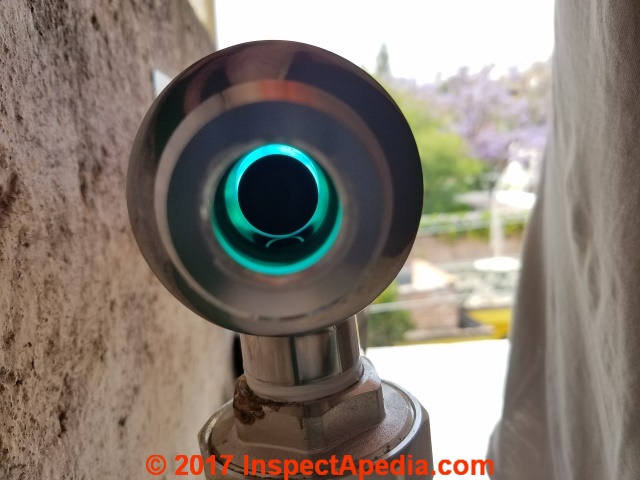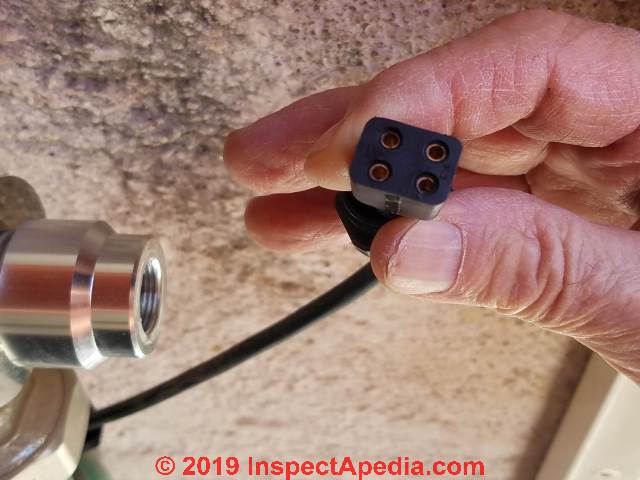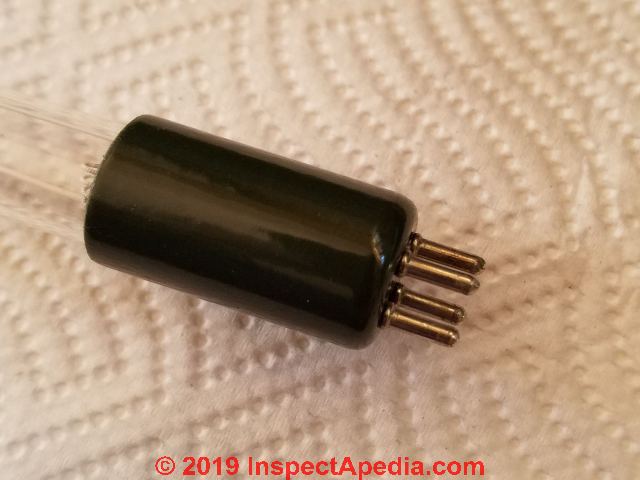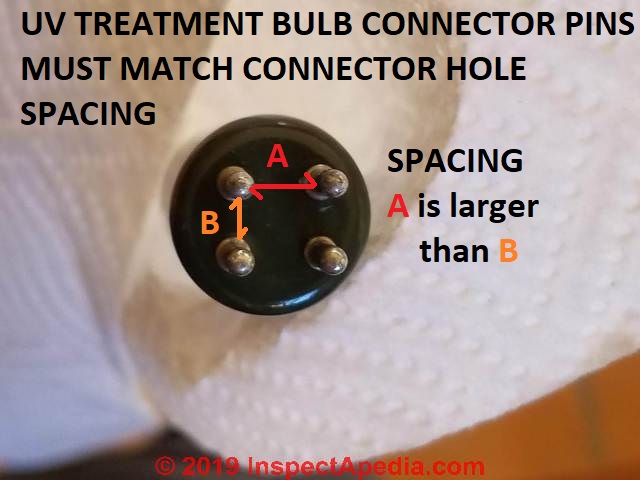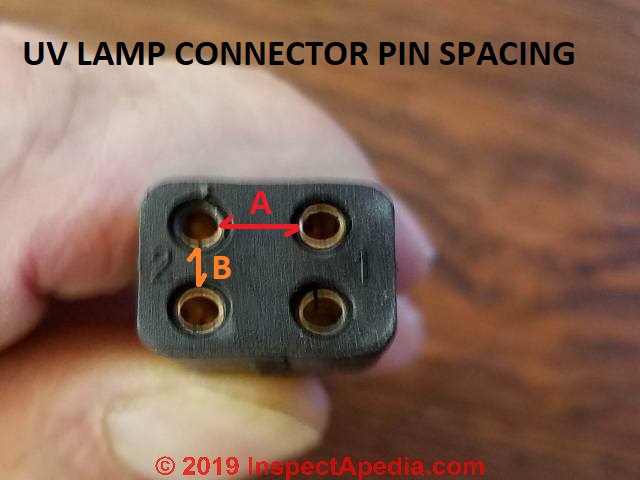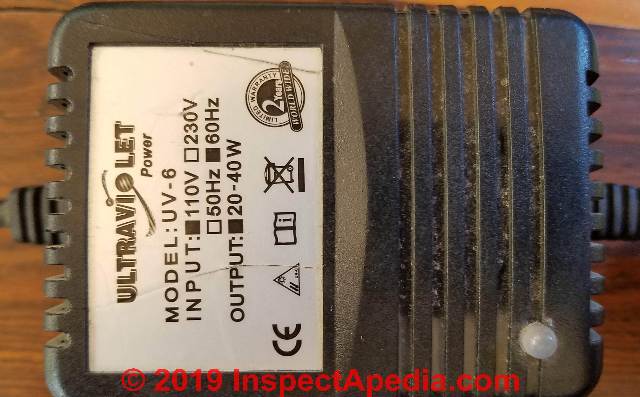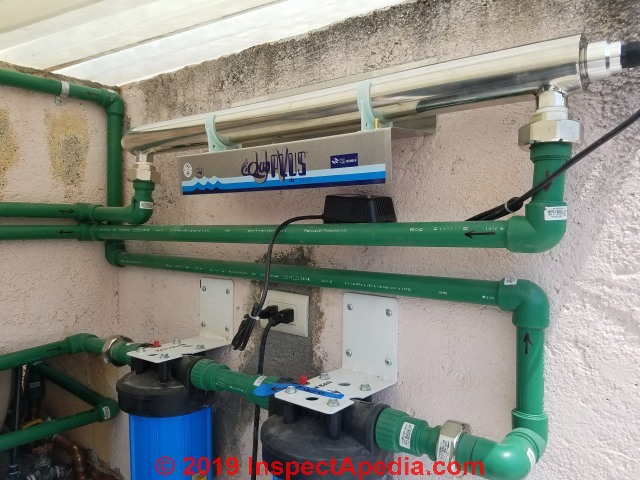 UV Light Disinfectant System Repair
UV Light Disinfectant System Repair
How to troubleshoot & fix problems with a UV treatment system
- POST a QUESTION or COMMENT about choosing, installing, & maintaining or repairing UV light water treatment systems or "water purifiers"
UV Water Purification Systems repair procedures.
Using an ultra-violet light water disinfection system that we installed in the home shown here, we illustrate how to repair or maintain the system - simply by changing a bulb, cleaning the light fixture, or replacing a bad power supply unit.
This article series gives procedures & reasons for using permanently-installed UV light (ultra violet light) treatment systems to address bacterial contamination in drinking water or well water - one of the options for correcting unsanitary or unsatisfactory drinking water.
InspectAPedia tolerates no conflicts of interest. We have no relationship with advertisers, products, or services discussed at this website.
- Daniel Friedman, Publisher/Editor/Author - See WHO ARE WE?
UV Lamp Water Disinfection System Troubleshooting
Above: we illustrate removing the black plastic cap to give access to the AquaPlus UV light bulb chamber.
This inspection port permits confirmation that the UV bulb is "lit" or working, though it may not indicate whether or not the bulb or chamber needs to be cleaned of sediment.
- UV Lamp is out: Remove the end-plug to confirm that you see a blue light - if so the bulb is working; See the photos above.
If the UV bulb is out:
1.1. Check that there is power delivered to the electrical receptacle where the UV treatment system is plugged in.
1.2. Check wiring & connector: Next check that the wiring is un-damaged and that the connector plug joining the bulb to its power supply is securely seated.
Follow the wires from the ballast that supplies voltage (typically 20-40VAC) to your UV treatment bulb. Wires may connect to one or to both ends of the bulb. In my example photos below the connector is at just one end of the bulb. We'll show the connector and the bulb pins to which the bulb connects. f
You may need to un-screw the plastic cap and slide it down the wire to see the actual bulb connector plug. Pulling the wire gently should pull the end of the bulb and its connector out of the tube.
Above: unscrew the connector retainer;
this bulb uses four pins at one end - the plug pin spacings prevent improper connection to the bulb. .
Below: Watch out: the connector can plug to the bulb in two ways but not four ways.
The pairs of pins are not equally spaced. If you remove and re-connect the UV bulb connector, as you must do when replacing the bulb,
take care that the holes in the connector properly match up with the spacing of the pins on the bulb.
1.3 Check for a bad ballast: if the ballast alarm sounds even though a new bulb is installed OR if the ballast is not delivering power to the bulb you'll find no voltage between the connector pins. Replace the ballast.
Below: the ballast used with the UV water disinfection system shown above.
- UV Lamp Ballast Alarm sounds: if you hear a horrible high pitched shriek coming from the UV disinfection lamp ballast check also it's warning light; you'll probably see that instead of the normal green light (meaning all is OK) the lamp will be orange or red.
Check for a bad bulb: The alarm on a UV lamp disinfection system may sound if the bulb is no longer working - which means you need to replace the bulb.
Watch out: take care not to damage your eyes looking directly at a UV light
Check for a bad ballast itself: if the bulb looks good and is fully ignited along its length and particularly if also the bulb is new, then the problem is most-likely a bad ballast. Replace the ballast. - Leaks at the UV Water Disinfectant Lamp: check for a damaged, nicked, or improperly-seated O-ring. You can obtain replacement O-rings from the manufacturer or some auto or plumbing suppliers can match an O-ring locally. Take care: the replacement ring must match exactly or the light will leak and may be unsafe.
If the leak is at a plumbing connection you'll need to turn off water, drain off water pressure, and re-make the plumbing connections using an appropriate plumbing sealant or teflon tape. - Inadequate water disinfection: if a bacteria test shows that your UV light is not killing all bacteria (bacteria is killed, not removed)
4.1 Check the bulb to be sure it's lit.
4.2 Check or clean the quartz tube into which the UV bulb is inserted. You'll need to follow the specific water UV disinfectant system instructions for your partcular device to remove and clean the quartz tube. Obviously take care not to break the tube.
Shown below: the UV bulb used in the water disinfection system shown here is the Wonder-Light GPH843T5L/40W - a 40-watt bulb. (About $30. U.S. or MX$ 600.)
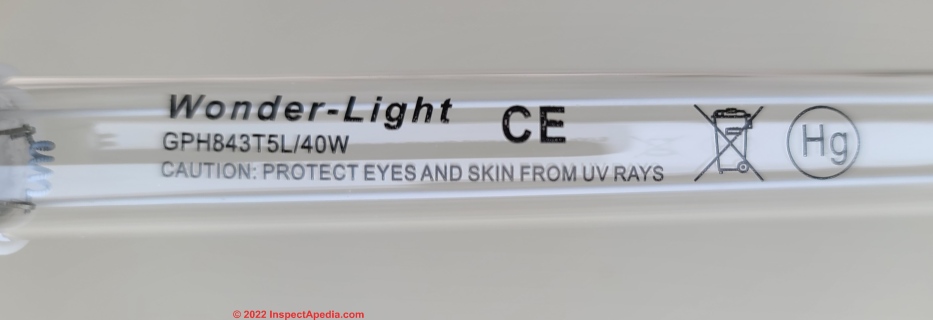
Some suppliers list it simply as a T540 Lamp or as a T5L40 UV Lamp.
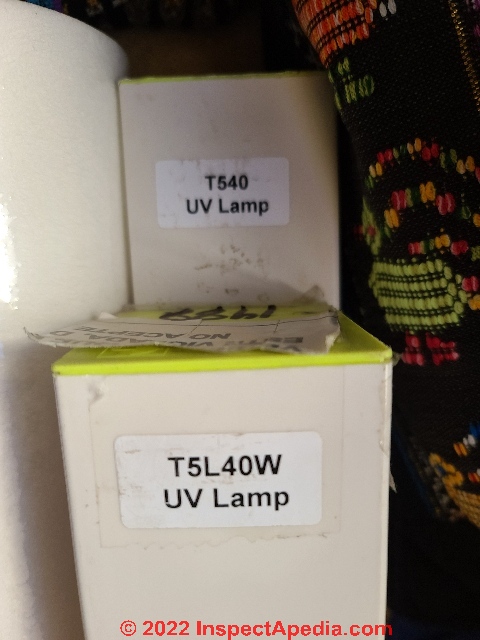
Watch out: When handling a new or replacement UV disinfection bulb take care to hold it by the factory-supplied foam block [photo below] as oil from fingerprints may cause damage or might affect bulb life.

4.3 Check the water flow rate through the UV disinfectant lamp system. If the flow rate in GPM or LPM is greater than the rated capacity of the lamp then you need to either reduce the flow rate (with a control valve ahead of the UV system) OR you'll need to replace the UV treatment system with one of adequate capacity.
For example, the AquaPlus UV water disinfection system model used for these illustrations is the Model 12-SS/UV that has a capacity of 45 liters per minute (a bit under 12 gallons per minute) of water flow rate and is designed for water pressures between 1.5 and 2 KG/cm2 (21.3 to 28.4 psi).
Watch out: it's the flow rate in GPM or LPM , not the pressure that will determine if your UV disinfectant light can work effectively.
For the AquaPlus (used throughout Mexico and sold in similar models in the U.S., Canada, the E.U., and Asia, typical residential UV water disinfection system flow rates, dependign on the model you select, range from 15 LPM (4 GPM) to 91 LPM (24 GPM) flow rates.
4.4 Check water filtration and other water contaminants: If your water is high in sediment or iron the ability of the UV system to effectiely disinfect the water flowing by the bulb will be significantly reduced.
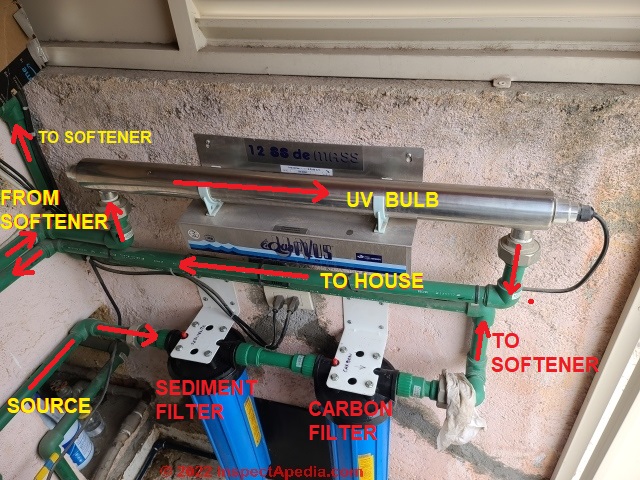
The UV disinfection system used as an example in this article is downstream from both a pair of filters and from a water softner (to remove high levels of calcium and magnesium that can coat piping as well as coat and disable the UV bulb).
The duplex high-capacity water filtration system that removes sediments and solids and a carbon filter that removes odors and some chemicals from the water supply.
If your water supply is high in iron
see WATER SOFTENER IRON & SEDIMENT REMOVAL
If your water supply is high in sediment
see WATER FILTERS, HOME USE
or WATER FILTERS - SEDIMENT & IRON
Watch out: even the best water filter system + water softener + UV disinfection system will not remove all water contaminants. Some such as arsenic may still remain.
See, for example, ARSENIC in DRINKING WATER
...
Continue reading at UV ULTRAVIOLET LIGHT WATER TREATMENT - home or select a topic from the closely-related articles below, or see the complete ARTICLE INDEX.
Or see these
Relate Articles
- FILTERS for DRINKING WATER PURIFICATION
- UV LIGHT BLACK LIGHT USES
- UV WATER DISINFECTION, PORTABLE for emergency or camping use
- DISINFECTION SYSTEMS, SEPTIC EFFLUENT where UV is also used
- WATER FILTERS, HOME USE - topic home
- WATER QUALITY & QUANTITY San Miguel de Allende
- WATER TREATMENT EQUIPMENT DISINFECTION
- WATER TREATMENT EQUIPMENT CHOICES - home
Suggested citation for this web page
UV ULTRAVIOLET LIGHT WATER TREATMENT REPAIR at InspectApedia.com - online encyclopedia of building & environmental inspection, testing, diagnosis, repair, & problem prevention advice.
Or see this
INDEX to RELATED ARTICLES: ARTICLE INDEX to WATER TREATMENT SYSTEMS
Or use the SEARCH BOX found below to Ask a Question or Search InspectApedia
Ask a Question or Search InspectApedia
Questions & answers or comments about choosing, installing, & maintaining or repairing UV light water treatment systems or "water purifiers"
Try the search box just below, or if you prefer, post a question or comment in the Comments box below and we will respond promptly.
Search the InspectApedia website
Note: appearance of your Comment below may be delayed: if your comment contains an image, photograph, web link, or text that looks to the software as if it might be a web link, your posting will appear after it has been approved by a moderator. Apologies for the delay.
Only one image can be added per comment but you can post as many comments, and therefore images, as you like.
You will not receive a notification when a response to your question has been posted.
Please bookmark this page to make it easy for you to check back for our response.
IF above you see "Comment Form is loading comments..." then COMMENT BOX - countable.ca / bawkbox.com IS NOT WORKING.
In any case you are welcome to send an email directly to us at InspectApedia.com at editor@inspectApedia.com
We'll reply to you directly. Please help us help you by noting, in your email, the URL of the InspectApedia page where you wanted to comment.
Citations & References
In addition to any citations in the article above, a full list is available on request.
- Siemens Ultraviolet Water Disinfection System, Sunburst - SBH series, 80 Commerce Drive, Allendale NJ 07401, 201-760-0364 or Siemens Headquarters, Water Technologies Group, 1901 West Garden Road, Vineland, NJ 08360
- Thanks to an anonymous reader for discussing water testing procedures following a UV light installation - 11 Sept 2009
- Hoff, John C., and Elmer W. Akin. "Microbial resistance to disinfectants: mechanisms and significance." Environmental Health Perspectives 69 (1986): 7.
- Qualls, Robert G., Michael P. Flynn, and J. Donald Johnson. "The role of suspended particles in ultraviolet disinfection." Journal (Water Pollution Control Federation) (1983): 1280-1285.
- Principles and Practice of Disinfection, Preservation and Sterilization (Hardcover)
by A. D. Russell (Editor), W. B. Hugo (Editor), G. A. J. Ayliffe (Editor), Blackwell Science, 2004. ISBN-10: 1405101997, ISBN-13: 978-1405101998.
- When Technology Fails, Matthew Stein, Chelsea Green Publisher, 2008,493 pages. ISBN-10: 1933392452 ISBN-13: 978-1933392455, "... how to find and sterilize water in the face of utility failure, as well as practical information for dealing with water-quality issues even when the public tap water is still flowing". Mr. Stein's website is www.whentechfails.com/
- In addition to citations & references found in this article, see the research citations given at the end of the related articles found at our suggested
CONTINUE READING or RECOMMENDED ARTICLES.
- Carson, Dunlop & Associates Ltd., 120 Carlton Street Suite 407, Toronto ON M5A 4K2. Tel: (416) 964-9415 1-800-268-7070 Email: info@carsondunlop.com. Alan Carson is a past president of ASHI, the American Society of Home Inspectors.
Thanks to Alan Carson and Bob Dunlop, for permission for InspectAPedia to use text excerpts from The HOME REFERENCE BOOK - the Encyclopedia of Homes and to use illustrations from The ILLUSTRATED HOME .
Carson Dunlop Associates provides extensive home inspection education and report writing material. In gratitude we provide links to tsome Carson Dunlop Associates products and services.



